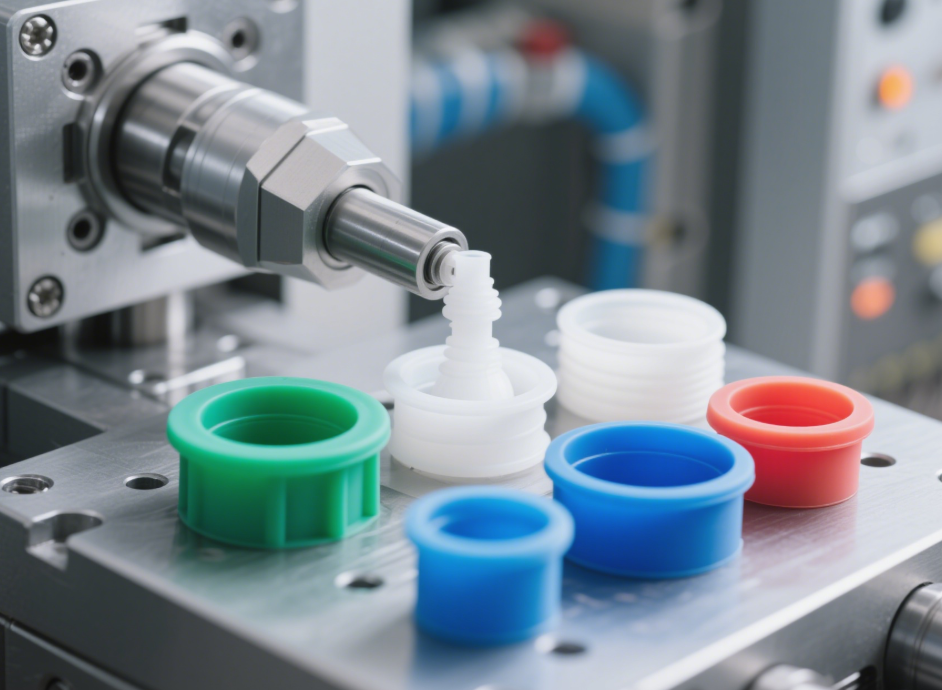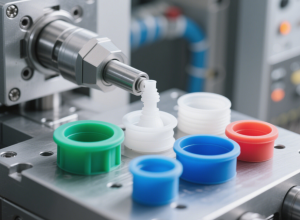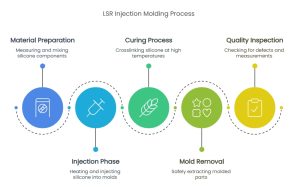LSR injection molding needs precise injection speed, mixing ratio, and mold temperature control to produce exceptional products.
Processing equipment must be qualified for viscous materials and give exact dosages. Vacuum and air-venting technology systems minimize void formation in micro-scale components. Inline mixing integration creates a perfect chemical mixture while removing over-curing and under-curing issues from the process.
These implemented measures empower the production of highly precise silicone shapes with high repeatability.
Table of Contents
ToggleWhat is LSR Injection Molding?
Liquid silicone rubber molding operates through rapid curing processes between two-part liquid silicones that generate multifaceted parts within precise tolerances in heated molding chambers. Note that the procedure stands apart from standard thermoplastics because its materials crosslink instead of melting for scrap-free runners and homogeneous mechanical characteristics.
The low-viscosity resin flows into micro features, which gives seals and gaskets for medical, automotive, and electronics applications. Its crosslinked structure lets the material possess high flexibility and durability while maintaining performance under exciting temperatures.
Automated mixing systems provide precise shot control while decreasing the possibility of contamination, which produces extraordinarily predictable results alongside nearly non-existent flash formation.
Step-by-Step Breakdown of the LSR Injection Molding Process
The LSR injection molding process is a precise method for creating high-quality silicone parts, involving several key stages from material preparation to final inspection.
Material Preparation
The first step of LSR injection molding entails exact measurements of Part A and Part B silicone. Components include catalysts, crosslinkers, and inhibitors. The static mixers combine components into a uniform ratio of 1:1 to ensure consistent flow properties.
Precisely controlling the mixed components helps avoid outgassing and micro-void formation. The accuracy of metering pumps ensures batch uniformity through tolerances, which might be near ±0.5% of measurement.
Injection Phase
During the injection phase, liquid silicone for molds is heated and maintained at a constant flow through the barrel to ensure smooth delivery into the mold. Short injection strokes help decrease shear heating. The designed nozzles inside the shutoff system protect the sprue from premature curing reactions. Multi-cavity molds require balanced runners to tackle complex parts that may feature tight dimensional needs while maintaining thin walls.
Curing Process
Platinum-catalyzed crosslinking controls the curing process in LSR injection molding by using high mold temperatures. Vulcanization speeds up in most molds when they operate at temperatures within the range of 140°C to 220°C[1].
Some formulations can cure their materials in an instant for improved efficiency. The elimination of mold parting-line flash needs specific clamping force settings, while engineered gaskets aid in this process. The final Shore A points of the molded product can change if the temperature goes above or below the required level.
Mold Removal
The process of removing molds during LSR injection molding depends on automated demolding systems. The mechanical grippers or air ejection systems safely remove parts without harming the cured silicone material.
Silicon parts release more easily from undercut-free design features, but some micro-scale components may require vacuum assistance for extraction.
Uniform finishes across mold surfaces lower the amount of friction that occurs. The robotic handling of parts protects the component quality and circumvents from material contamination risks.
Quality Inspection
Strong inspection methods form an essential part of LSR injection molding to identify shape alterations and surface imperfections. Critical diameters fall within the micron range, measured by laser micrometers.
The advanced vision system uses its capabilities to confirm the complete removal of gate remnants from convoluted components. Microtomes in cross-sectional mode show both cure gradient distribution and flow lines.
Inspection data from throughout history allows teams to detect tiny changes in injection pressure, which impact repeatability levels.
Cutting-Edge Techniques in LSR Injection Molding
Innovative techniques in LSR molding are driving advancements in precision, efficiency, and versatility in manufacturing high-performance components. Key techniques include:
Multi-Component Molding
Engineers fuse liquid silicone with rigid substrates in a single cycle. They use servo-driven tooling to index parts between shots. They optimize gating profiles to stop cross-contamination, which helps avoid post-assembly steps.
Silicone Overmolding
Designers treat substrates with plasma or chemical primers and inject molten silicone over them. The controlled interface tension increases mechanical adhesion, and this technique is common for soft grips and seals.
Micro-Molding
Molds have ultra-fine cavities and micro-venting channels. Shot volumes can be as small as a fraction of a gram. Precision feedback systems maintain exact fill levels while guaranteeing negligible flash and tight tolerances.
Automated and Smart Molding
Sensors track resin flow and in-cavity pressure in real-time. Machine learning algorithms predict process shifts. Robots manage demolding and assembly continuously to minimize manual errors and rationalize throughput.
Rapid Prototyping
LSR injection molding suits quick trials of flexible components. Small batch molds are machined with close-fitting tolerances. Engineers validate designs rapidly before scaling, which surely speeds up development cycles.
Solving Real-World Problems with LSR Injection Molding
LSR injection molding overcomes common challenges, offering precise production and faster turnaround for industries such as medical devices, automotive, and consumer electronics.
Key Challenges
Inconsistent quality
The part consistency problems of LSR injection molding become manageable through automated systems running in closed loops to maintain precise shot volumes and curing periods.
Long lead times
The manufacturing process attains rapid lead times by creating multiple cavity forms that construct complex shapes, such as medical pump microfluidic channels, at high production speeds without compromising tolerances.
Applications
Automotive
The two-part platinum-cured composition of LSR provides temperature stability with chemical inertness for automotive seals working under extreme heat and chemical exposure.
Consumer Electronics
Low compression characteristics of this material power the development of consumer electronics since it produces durable gaskets and vibration dampeners.
Medical Devices
Used in microfluidic channels for medical pumps, LSR provides the necessary precision and durability.
Like: Trusted Partner for LSR Injection Molding
Like is a dependable manufacturer specializing in liquid silicone solutions for industries like automotive, consumer goods, and medical, with a focus on quality and innovation. We can promise you:
- Advanced equipment
Like operates liquid silicone rubber injection molding through more than 100 molding machines, including 10 Arburg machinesand 20 assembly lines, so that we can provide accurate molding solutions.
- Experienced team
With 13 years of experience, our expert team has provided comprehensive services that include customized research, development, and production of silicone products.
- Quality assurance
We hold ISO 13485 and ISO 9001 certifications to ensure top-tier product quality.
- Instant quoting and quick turnaround
We produce new mold orders in 15-30 days using rapid manufacturing methods that provide prompt estimates and fast delivery to satisfy customers quickly.
Conclusion
LSR injection molding plays an important role in producing high-quality silicone products with exceptional precision and innovation. At Like, we combine innovation with advanced techniques to deliver custom solutions that meet your needs. Reach out today and let us help you create desired silicone products!
Reference
- Calculating the temperature and degree of cross-linking for liquid silicone rubber processing in injection molding. Available at: https://aiche.onlinelibrary.wiley.com/doi/10.1002/amp2.10072. (Accessed on April 9, 2025)









